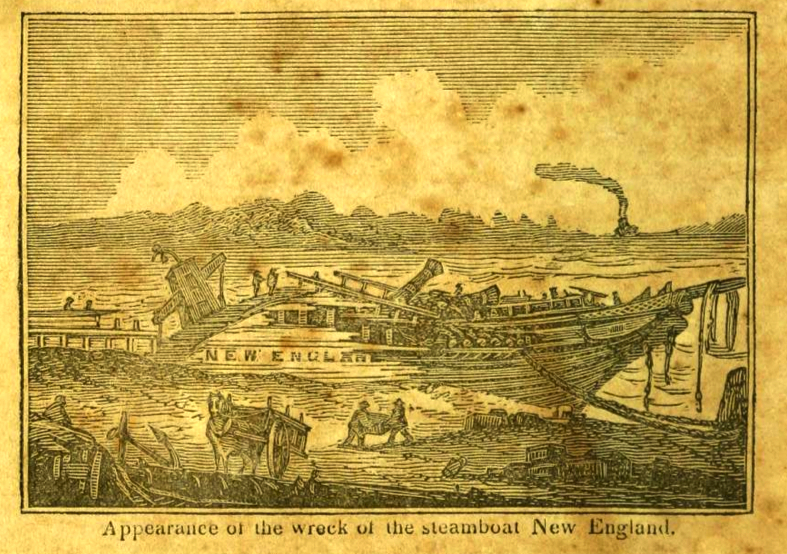One of Connecticut’s worst steamboat disasters occurred on the dark and stormy night of October 8, 1833, on the Connecticut River. According to Steamboat Disasters and Railroad Accidents, the New England had left New York with about 70 passengers and 20 crewmen on October 7th, destined for Hartford and traveling in the company of the Boston, another steamboat. The two boats appeared to be in a race until they parted at the mouth of the Connecticut River at about 1:00 in the morning. At that point some difficulty occurred with the New England’s engine but 30 minutes later, with the problem fixed, she continued upriver, arriving off Essex at 3:00 am. The engine was stopped but, as a small boat was lowered to land a passenger, both boilers exploded “with a noise like heavy cannon. The shock was dreadful; and the scene which followed … [w]as awful and heart-rending beyond description.”
The ladies’ cabin suffered the worst effects: “Those who, … on first alarm, sprang from their berths, were more or less scalded. All who were on deck abaft the boilers, were either killed or wounded….” The heat from the steam was so great that, an unidentified eyewitness reported, one victim’s clothes “were so hot as to scald the hands of those that removed them.… Letters, exposed to the steam, were charred, or reduced to coal in places.”
The captain was in the wheelhouse directing the landing of the passenger and jumped, or was thrown, to the forward deck, sustaining only bruises. Thirteen people perished, including five crewmen. An unidentified survivor noted that the people of Essex took the survivors into their homes and “every thing which could contribute to their relief and comfort promptly [was] afforded.”
The cause of the disaster was determined to be negligence on the part of the substitute engineer, possibly for letting excessive steam build up during the stop for engine trouble earlier that night.
Contributed by Emma Demar, a Connecticut Explored intern and Trinity College student in 2011, and Elizabeth Normen, the magazine’s publisher.
© Connecticut Explored. All rights reserved. This passage originally appeared as part of the article “What a Disaster!” in Connecticut Explored (formerly Hog River Journal) Vol. 9/ No. 4, Fall 2011.
Note: ConnecticutHistory.org does not edit content originally published on another platform and therefore does not update any instances of outdated content or language.









